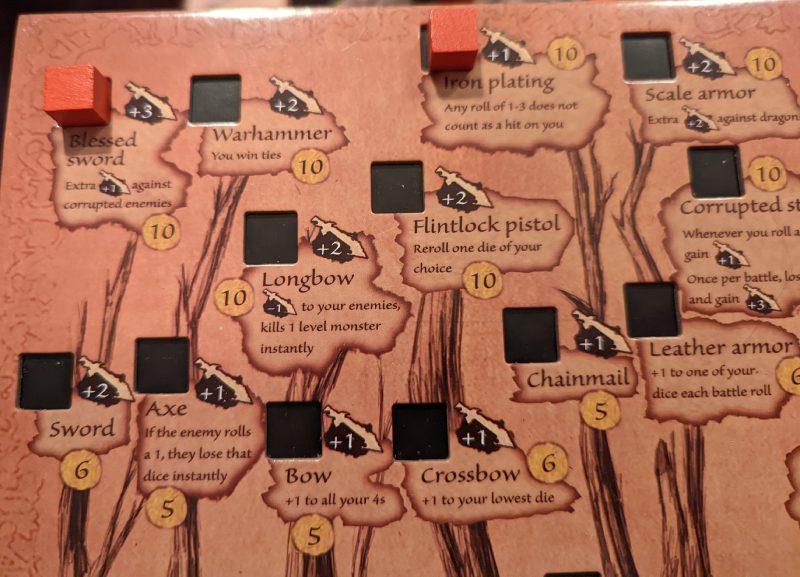In my Libertalia review, I joked that I spent a good chunk of change upgrading my gaming computer hardware to play video games. While there is some truth to that, I do have a guilty pleasure when it comes to video games. Even with powerful hardware, I enjoy playing old emulated arcade games. Over a thousand dollars were spent on a video card only for it to render 30-year-old games. I never said I was smart.
This love of guilty pleasures isn’t limited to video games, as this also extends to board games. Contrary to the years of luckless propaganda in tabletop gaming, I enjoy rolling dice. Maybe it’s because it’s one less thing for the analysis paralysis crowd to think about, or I like risk assessment. Either way, I cannot deny my passion for the white cubes and black pips.
Now just because I said I don’t mind a bit of luck, doesn’t mean I’m into games like Xia: Legends of the Drift System or Talisman. Adventure games often have bloated rules, take way too long to finish, and make you feel more like a front-seat spectator than an active participant.

A familiar story
Here Be Dragons: Into the Unknown wants to challenge that status quo. It uses dice, tiles, and cards for randomization married with euro design sensibilities. At least, I think it is a euro design since the game is full of brown, has wooden cubes, and an overwritten rulebook.
The premise of the game is plain as raw tofu. You and your opponents are adventurers and all of you will scatter around an unknown landscape in search of fortune and glory. The only thing you have is the starting ship tile surrounded by nothing. It’s time to explore this new land.
Like many other euro games, this one is about victory points, and this is a race to the almighty 10. This involves slapping steel, creating settlements, slinging spells, completing quests, and possibly fighting a boss. I mention the last part “possibly” since bosses are an optional element that you can throw in.
Going through a turn is as simple as the premise itself. The first thing you do is move to a tile. If it’s unexplored, you draw from the bag and lay it on the table. After laying it, it’s time to collect income from your settlement and draw an Event card.
It’s an interesting life
Event cards come in three flavors. Quest cards are immediately placed face up for everyone to see, and it’s the typical “first to finish” mechanic that involves a task such as killing a particular monster type or attacking another player. Choice cards give you a situation where you pick the outcome, giving you a bit of narrative spice. The last part is Equipment cards, which you keep in your hand, and these are typical cards that “break” the rules of the game, with some of them being “take that” cards. This will eventually become a problem.
After dealing with the Event cards, it’s time to interact with the tile. This is where the bulk of the action comes from, where you can hunt for monsters on your tile, build your settlement, use spells, and attack other players. After doing your interactions, you will place your Travel Marker, signaling the end of your turn and programming your next turn’s movement.
Going through a turn is rather easy, and the pacing bounces between your friends in a New York minute. Obviously, there is a bit more to the game than I just described.
Like that giant beautiful dual-layered player mat in front of you. It not only tracks your health and victory points but several other items of interest. You pay Influence to attack other players or earn victory points. Using Resources will improve your settlement while spending Gold moves you up on the Tech Tree.

Moving up in the world
The Tech Tree is, well, a tree on your player mat. You start with two cubes at the bottom, and by spending Gold, you will move one upward along the branches. The Tech Tree serves only to improve yourself in combat, with each branch representing different areas such as weapons, magic, and armor. The idea behind this setup is you can seek out different combinations, such as wielding an axe and crossbow, or if you want to go against tradition, a frost staff with full plate armor. Unlocking these items grants more dice to roll in combat and abilities to leverage.
Yes, dice, since this is gaming emulating the adventure board games of old after all. It is a system similar to Risk or Spartacus, where you compare your highest results to your lowest and eliminate dice that beat your opponents. Keep rolling until one side has no dice.
You might think this is extremely basic, and you would be right. However, there is where the Tech Tree abilities and monster traits will come into play. Certain items in the Tech Tree can do various things like outright ignore a trait, grant a bonus towards flying monsters, or having all of your 4s get a +1. As for monster traits, there are numerous ways to mess with you, such as re-rolling dice that don’t hit, every hit giving them a new die, or being immune to Spell cards.
Spell cards are another level of interactivity. Someone can chuck a Fireball to remove your two battle dice during combat, or you can Teleport yourself five spaces around the map. It does mean that when a player starts gaining the upper hand, the game falls into a typical trap of “play bad stuff on bad person” nonsense that plagues these types of games.
I’ll admit that I have mixed feelings towards the combat system. Unlike many board game critics, I don’t look down at dice. If done well, they can be quick, entertaining, and unpredictable. Here Be Dragons wants you to focus on building towards the fight instead of making the fight itself engaging. Nevertheless, I can’t overlook how annoying the spell cards can be or how easily the monster traits can be abused.

Starting a new home
Besides building your Tech Tree and going into combat, you can also create a settlement. Once created, you can start spending your Resources to plop down district cubes signifying your ownership. Anyone who tries to enter pays you two Gold. Some tiles will produce Resources, and owning them gives you an income. Every third district cube increases the level of your Settlement, and there are four levels.
Settlements are vital to your success since they are a permanent gold income and give one-time bonuses of victory points and Influence. Half of your victory points will come from your settlement, and that gold income will serve you well when you need to build your Tech Tree. I will even say that it almost has too much sway over your victory.
Some of you probably noticed at the end of every explanation that I throw in a negative jab. There is a reason for this: I don’t like this game.
I know it’s taboo for a board game critic to be blunt like this, but despite the multiple chances I gave this game, I was never satisfied with the experience. It’s a bit painful to state this because I know the designer put some serious love into this product.
The simple rules, the wonderfully crafted wooden pieces, and the sketchy art direction of the components present this experience that feels like an 80s board game that you stole from a thrift store. I was interested in Here Be Dragons since it appeared to be an abridged version of the adventure genre.

Pretend nostalgia
Perhaps I am having a grandpa moment, but the current state of adventure board games is unappealing to me. Most of them take way too long to finish, mainly due to the complex rules. It shouldn’t take half a dog’s lifespan to clear out a single dungeon room. It doesn’t help that these games have boxes that are big enough to function as a makeshift dog house. Here Be Dragons seemed to be the answer here.
Much like grilled undercooked meat, appearances can be deceiving and problems arise once you take a bite out of it.
Let’s go back to the settlement for a moment. When you place a district cube on a tile that produces Resources, that’s your income. Nothing wrong with this. To place a district cube, you need to spend 2 Resources. That also includes level 2 to level 3, or level 3 to level 4. In other words, your Resources income increases significantly but the cost to expand doesn’t, leading to a snowball effect that even the most northern of Canadians will call you out on.
Even worse, plains tiles are needed to place a settlement. You can spend a good half of the game bumping into trees and mountains, leading you down a path that doesn’t provide the necessary income to power up your character.
And you will need to power up since combat is slanted against you. It’s nothing to do with the dice, and I’ll repeat that I’m okay with that. It’s the monster traits.

Dice favor the lucky
Some monster traits ignore your decisions. Swarmer gives an extra die if the monster hits you, meaning a bad roll on your end can lead to a nasty ending. It is possible for a creature that has one die to take down your character with four dice. I’ve seen it happen multiple times.
If that does not sound silly enough, there is Stealth. It’s easy to explain. Before combat starts, they roll a die, and if it’s six, the monster immediately defeats you. That Blessed Sword that you just acquired in your last turn? Who cares.
The sad thing is I could keep going. You can lose in a speculator fashion after maxing out your Tech Tree because the bosses are stupidly strong. Attacking other players is not a viable tactic since everyone moves, for the most part, one space at a time, and movement is programmed. I could talk about the “take that” spells that make even the straightforward battles feel like marching through a minefield of nonsense. Quest cards sound neat until you realize that they are often more rewarding than fighting powerful risky monsters. Additionally, I have played this solo a few times, and I can assure you a good portion of equipment cards are completely useless in a solo setting.
Here be Dragons: Into the Unknown comes across as an underdeveloped title. Although it has the right intentions, it achieves little due to its execution. I almost feel like I can house rule this game to an excessive degree to create a more palatable experience. When that thought enters my mind, that’s a death sentence for any game.











Add Comment